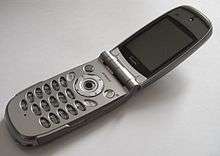Freedom of Mobile Multimedia Access
Freedom of Mobile Multimedia Access (FOMA) is the brand name of the W-CDMA-based 3G telecommunications services being offered by the Japanese telecommunications service provider NTT DoCoMo. It is an implementation of the Universal Mobile Telecommunications System (UMTS) and was the world's first 3G service to commence operation.

NTT DoCoMo also offers HSPA services branded FOMA High-Speed (FOMAハイスピード), which offers downlink speeds up to 7.2 Mbit/s and uplink speeds up to 5.7 Mbit/s.[1]
History
NTT DoCoMo developed the W-CDMA air interface, which is a form of DS-CDMA (Direct Sequence CDMA), in the late 1990s. It was later accepted by ITU as one of several air interfaces for IMT-2000 and by ETSI as one of three air interfaces for the UMTS.
NTT DoCoMo originally planned to launch the world's first 3G services, initially branded Frontier of Mobile Multimedia Access (FOMA), in May 2001.[2] However, by May 2001, NTT DoCoMo had postponed the full-scale launch until October 2001, claiming they had not completed testing of their entire infrastructure, and would only launch an introductory trial to 4,000 subscribers.[3] In doing so, they also renamed the service to Freedom of Mobile multimedia Access.[3] In June 2001 trial subscribers complained the mobile phones had insufficient battery life and crashed frequently, that there was inadequate network coverage, and that there were security issues within the handset itself.[3] As a result, DoCoMo recalled 1,500 handsets by the end of June 2001. FOMA successfully launched in October 2001 providing mobile telecommunications coverage to Tokyo and Yokohama.[3]
Initially - as the first full-scale 3G service in the world[4] - FOMA handsets were of experimental character targeting early adopters, and were big, had poor battery life and the network covered the center of Japan's largest towns only. For the first 1–2 years, FOMA was essentially an experimental service for early adopters - mainly communication industry professionals.
As NTT DoCoMo did not wait for the finalisation of the 3G Release 99 specification, their network was initially incompatible with UMTS.[5] However, in 2004 NTT DoCoMo performed wide-scale upgrades on its network, bringing it into compliance with the specification and enabling 100% compatibility with UMTS handsets, including incoming and outgoing roaming.
Around March 2004, FOMA achieved the breakthrough into mass sales, and sales soared. As of September 29, 2007, FOMA had over 40 million subscribers.[6]
Terminals
NTT DoCoMo offers a wide range of FOMA branded terminals, which are made specifically for the Japanese market. FOMA terminals differ from Western UMTS terminals in several aspects, for example:
- Standardised menu structure and chargers.
- Japan-specific features such as i-mode or Osaifu-Keitai (electronic purse).
- Multiband-support, which includes band VI at 800 MHz for FOMA Plus-Area (newer models).
- No support for dual-mode operation with GSM/EDGE (except some models branded as World Wing).
Frequency allocations
In metropolitan areas, FOMA uses the UMTS band I around 2100 MHz, which has been originally assigned to IMT-2000 services worldwide, except in the Americas.[7]
In order to improve coverage in rural and mountainous areas, NTT DoCoMo also offers FOMA services in the 800 MHz band originally assigned to the 2G PDC mova service, which corresponds to UMTS band VI and is similar to band V used in the United States.[7] These extended service areas are branded FOMA Plus-Area (FOMAプラスエリア) and require multiband terminals.
References
- NTT DoCoMo. "FOMAハイスペード" (in Japanese). Archived from the original on 2009-04-21. Retrieved 2009-06-10.
- Yabusaki, Masami (2001-03-12). "3GPP TSG_SA Vice-Chairman Nomination" (PDF). Retrieved 2009-02-12.
- ICFAI Center for Management Research (2003). "ICMR Case Collection: DoCoMo - The Japanese Wireless Telecom Leader" (PDF). Archived from the original (PDF) on December 29, 2009. Retrieved 2009-02-12.
- "NTT Docomo Case Study | Picsel Technologies". Picsel. 2007-11-19. Archived from the original on 2009-09-14.
- Hsiao-Hwa Chen (2007), John Wiley and Sons, pp. 105–106, ISBN 978-0-470-02294-8 Missing or empty
|title=(help) - "3G FOMA Subscribers Exceed 40 Million". NTT DoCoMo. October 2, 2007. Archived from the original on October 3, 2007. Retrieved 2007-10-03.
- Okada, Takashi. "Mobile Terminal RF Circuit Technology for Increasing Capacity/Coverage and International Roaming" (PDF). NTT DOCOMO Technical Journal. 10 (2). pp. 47–56. Retrieved 2009-06-10.